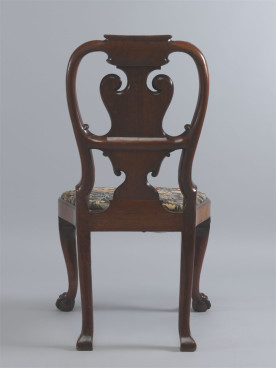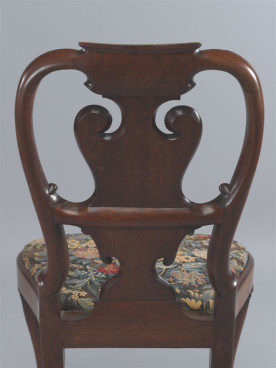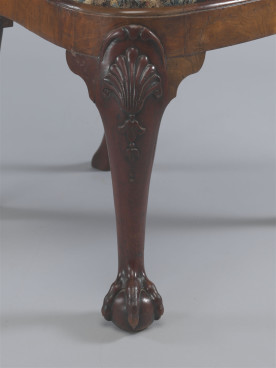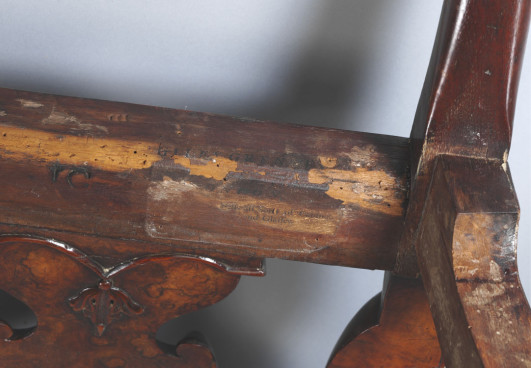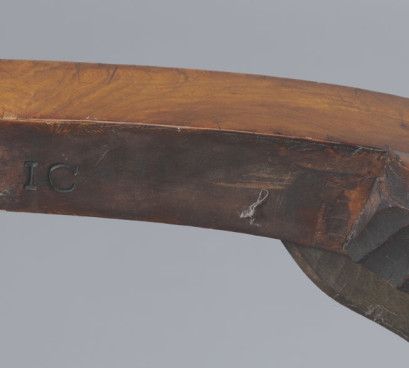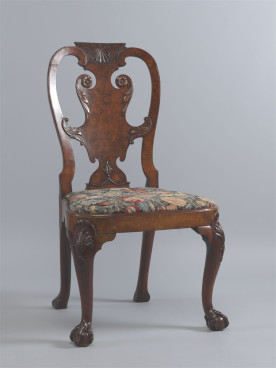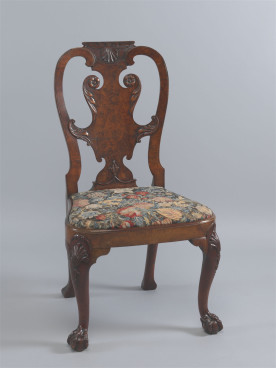Chair, c.1735–45
Walnut, now with 18th-century needlework
The rear seat rail has the remains of a paper trade label bearing the name Giles Grendey. The four seat rails are stamped ‘IC’; the back seat rail is stamped ‘ID’. This chair is one from a larger set that included armchairs.
Adam Bowett Catalogue (19/08/2012)
Description
A walnut chair, c.1735. The waisted and scrolled back has shell-carved tablet to the centre of the crest rail, over a shaped baluster splat linked by decorative scrolls to the uprights, the shoe being shaped with a sharp peak to the centre, the compass slip-seat is covered with floral needlework and raised on shell-carved cabriole legs with bell flowers and claw feet. The back legs are raked and straight, with squared pad feet.
Dimensions
H: 38 ½ “ (98cm) Seat height: 17” (43cm) W: 21 ¾ (55cm) D: 20 ½“ (52cm)
Designer / Maker:
Giles Grendey (1693-1780)
Materials
Walnut, beech, upholstery materials
Dating criteria
The shell knee and claw foot are typical devices of the 1730s and this is consistent with the evidence of the Giles Grendey label, which occurs on his furniture made in the 1730s and 1740s.
Construction
The entire chair is walnut with the exception of the front and side seat rails which are beech. The rear posts, splat, and crest rail are solid walnut, faced above the seat with figured walnut veneers and applied carved elements. The exception to this is the tablet in the centre of the crest rail which is carved from the solid. The shoe is solid walnut, faced with walnut veneer and is planted on to the back rail proper. It is much deeper than is usual, so that the bottom half-inch forms part of the back rail. The splat is constructed in two halves, an upper and a lower section housed into the middle cross brace; it is also thicknessed at the extremities to provide the necessary width. The splat is tenoned into the crest rail and into the shoe; the cross brace at mid-height is housed (presumably tenoned) into the back posts. The posts are thicknessed out at the extremes of the curves. The back rail is tenoned into the rear posts and single pegged; the side and front seat rails are veneered on their outward faces and have an applied long-grain ovolo moulding to retain the seat. The side rails are tenoned into the back posts and are secured with double pegs; at this point the rail is given further depth with the addition of a shaped walnut block which effectively doubles the length of the tenon. At the front the rails are tenoned into the front legs with bare-faced tenons. Additional curved braces have been screwed into the inside of the rails to reinforce the joints. The front legs are solid walnut, with shaped walnut brackets to either side of the knee and further shaped walnut blocking behind. The ball feet are thicknessed on the two outer faces to provide additional depth to the carving. It is impossible to determine the condition of the drop in seat because it is completely enclosed by the upholstery.
Marks or stamps
The chair is stamped four times IC, once on each of the seat rails. The back seat rail is also stamped ID. NB: ID is an impressed stamp whereas IC is burned in. The rear rail has the remains of a paper label bearing the name Giles Grendy. The top of the front seat rail is marked I.
Condition
The chair is substantially original, the only significant additions being the curved blocks screwed inside the front corners of the seat frame. There is some historic worm damage to the seat rails and the back seat rail has exposed sapwood in the inside corner which is badly degraded. The front left and right side brackets are replaced, as are at least two of the supporting blocks behind. The pegs securing the side rails to the rear posts are replaced. Sections of the ovolo seat moulding are replaced together with some veneer on the rails. There are stress fractures in the veneer of the splat and at some points in the front face of the seat rail.
Additional remarks
This chair is one of a set, now dispersed, but thought to have come originally from Sprotborough Hall, Yorkshire, seat of the Copley family (later Bewicke-Copley) where three chairs and two armchairs were recorded in 1922 (Wood [2008], I, p. 255, n. 38). More recently, three chairs and one armchair were in the collection of J.S. Phipps of Long Island, and sold by Sotheby’s in New York, 21 November 1981, lots 233-35. Two chairs reappeared at Sotheby’s New York, 20-23 April 1983, lot 755. Of these, of these, one is now at the Chicago Institute of Art (1983.718) and the other is at the Carnegie Museum of Art (83.38).
All the chairs from this set are marked with two sets of initials – ID and IC (the latter sometimes misrepresented as TC). It has been assumed that these are the initials of the workmen involved in their manufacture, but a chair of this type would usually be made by one man, not two. Moreover, while ID is an impressed mark, of the kind found on a number of Grendey chairs, IC is larger, and appears to have been burnt in with a brand. It is possible, therefore, that this is an inventory or ownership mark. The initials may relate to the owner of Sprotborough Hall, Joseph Moyle, who took the name Copley when he inherited the estate through his wife.
References
Macquoid, The Age of Walnut, London (1905), p. 206, fig. 192.
Cescinsky, The Gentle Art of Faking Furniture, London (1931), pl. 161 (left).
Azard & G. Bland, ‘English Taste, American Flavor’, The Connoisseur (July 1981), pp. 215-217.
Edwards (ed.), The Dictionary of English Furniture, 3 Vols., London (1954), I, p. 257, fig. 95.
Nicholas Grindley, The Bended Back Chair, exh. cat., London (1990), No. 20.
Christopher Gilbert, Pictorial Dictionary of Marked London Furniture, 1700-1840, Leeds (1996), p. 242, fig. 434 (Carnegie chair)
Lucy Wood, Upholstered Furniture in the Lady Lever Art Gallery, 2 Vols., New Haven and London (2008), I, cat. nos. 20 & 34, Fig. 152.
Provenance
S. Phipps, sold Sotheby’s New York 20-21st November 1981, lot 234.
Purchased from M. Turpin 26th May 1992




